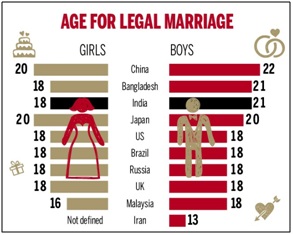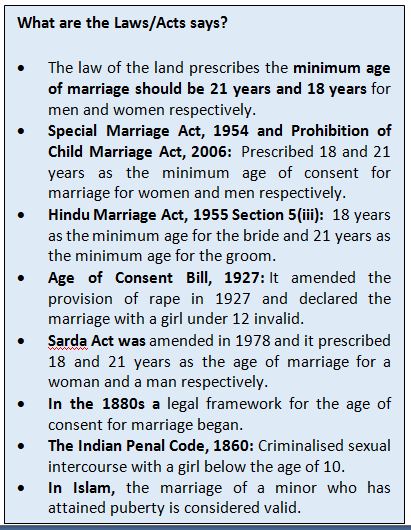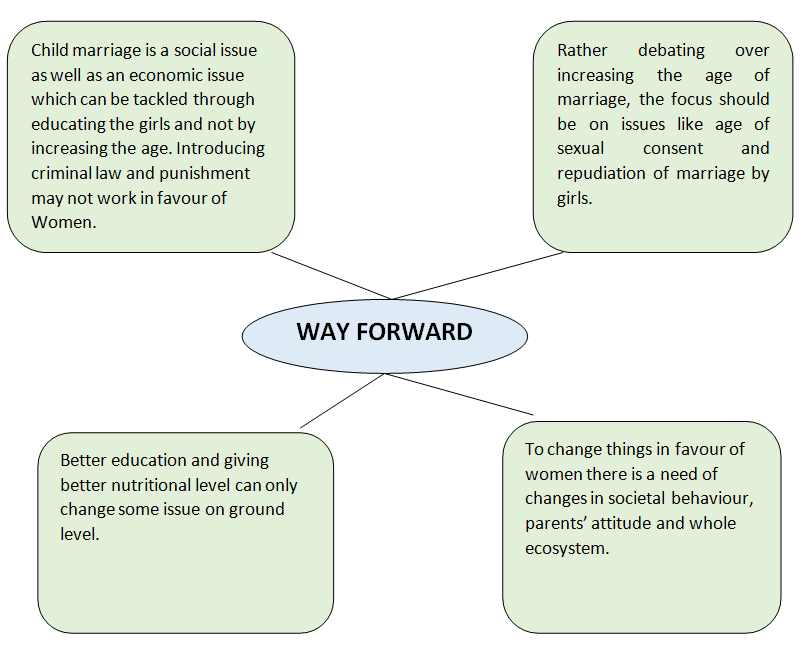Issue of Marriageable Age for Women
- Posted By
10Pointer
- Categories
Society
- Published
18th Mar, 2021
-
-
Context
|
Sub-topics
Society (GS-I)
- Salient features of Indian Society, Diversity of India.
- Role of Women and Women’s Organization, Population and Associated Issues, Poverty and Developmental issues, Urbanization, their problems and their remedies.
|
The debate of marriageable age of women began after the Independence Day speech of Prime Minister in which he announced that the government will soon take a decision on the age of marriage of women.
-
Background
- The whole issue arose after a task force was set up by the Union Ministry for Women and Child Development to examine issues like-
- age of motherhood among girls
- the correlation between age of marriage and Maternal Mortality Ratio (MMR), Sex Ratio at Birth (SRB), Total Fertility Rate (TFR), and Child Sex Ratio (CSR), etc.
- The committee is headed by former Samata Party president Jaya Jaitely and its members include NITI Aayog Member (Health) and several Secretaries to the Government of India.
- It will also examine the possibility of increasing the age of marriage for women from the 18 years to 21 years.
-
Analysis
Issue of Child Marriages in India
- Near about 650 million girls & women alive today were married as children, and by 2030, almost 150 million girls under the age of 18 will be married.
- India has contributed to a 50 % decline in child marriage in South Asia—to 30 % in 2018, the region still accounts for the largest number of child marriages.
- In India, among girls married by age 18, 46 % were also in the lowest income bracket.
- According to UNICEF, at least 1.5 million girls under the age of 18 are married in India each year. India has the largest number of child brides in the world i.e. 1/3rd of the global total.

-
What are the possible reasons of marrying girls at Low Age?
- Lack of education: Under-age marriages are prevalent in those regions and groups where there is a lack of quality schooling and opportunities for higher education.
- Social norms: There is a social norm in India which expects women to be younger than men at the time of marriage.
- Other reasons include-
- Poverty
- lack of quality education
- economic prospects
- security concerns
-
How early marriage impacts?
- Multiple diseases: The nutritional needs are high at late adolescence (15-19 years) and a fair measure of adolescent girls suffer from multiple forms of undernutrition, from chronic energy deficiency, iron deficiency to micronutrient deficiency.
- The marriage and delivery during adolescence drain their already poor nutritional reserves, and also lead to child stunting and mortality to multiple diseases at a later stage.
- Toll on mental health: Psychologically, women married as children are more likely to suffer from symptoms related to post-traumatic stress disorder (PTSD) and symptoms of depression.
- Low access to education: Marriage dramatically limits a girl’s access to education.
- Domestic violence: According to the International Council of Research On Women (ICRW),women with low levels of education and married adolescents between the ages of 15-19 years old are at a higher risk of domestic violence than older and more educated wome
-
Assessing pros & cons of increasing the marrigeable age
Arguments in favour
- Reduced maternal deaths: It will help in lowering maternal deaths and improving nutrition levels in the near term by putting more number of girls in college and enabling them to achieve greater financial independence in the long-term.

- Keeping population in check: Helpful in controlling the population as it may help in keeping the population in check.
- Improved health: It would be helpful for Children’s health and Women’s overall development as the children who are born to mothers who tend to get married at an early age may develop health problems.
- Equality: Increasing the age of marriage will make the marriage age equal for both men and women.
- The National Human Rights Commission, 2018 recommended that there should be a uniform age of marriage for boys and girls.
- Women’s Health: Increasing the Marriage age can reduce Mortality Rates and can reduce the diseases like anaemia among them. (young mothers are more susceptible to anaemia)
- Enormous opportunities: Increasing women’s legal marriage age will give more power and legal support to all women so that they can choose the opportunities to educate and empower themselves, before being burdened with marriage and motherhood.
- Increased participation in labour force: India will get a large number of labour forces by increasing the marriageable age. In India Female labour Force participation is too low as compared to world average.
Arguments against
- Issue of girl’s right: An increase in age to 21 years would mean girls will have no say in their personal matters until they are 21. Hadiya case is an apt example, where an adult woman’s decision to marry was challenged by her parents.
- The elementary right of minors such as right to be heard and the right for their views to be considered, can be denied to girls up till 21.
- Girls do become sexually active before 21 and if the government increases the age, several of them would not avail the formal healthcare system for their reproductive or sexual rights.
- The cases of child marriage can go up since the legal age for marriage will increase from 18 to 21.
- At the current age of marriage for women and men, the implementation of the child marriage law is very hard.
- Laws preventing child marriage can be misused:
- The child marriage law is mostly used by parents against eloping daughters.
- It becomes a weapon for parental control and for punishment of males whom girls choose as their husbands.
- Most of the cases that are taken to court are self arranged marriages. Only one third of the cases relate to arranged marriages, which are sometimes brought by parents or husbands to dissolve or to nullify marriages that have broken down because of domestic violence, dowry or compatibility issues.
- Marriage age of boys can be reduced to attain Equality:
- The age of marriage should be uniform for men and women but not by increasing the age but by reducing the age for boys.
- Indian Majority Act, 1875: It grants the right to vote, and to enter into contracts, for those who attain the age of 18. And they are equal for men and women.
- In the ‘Independent Thought case’ the Apex Court, declared that it’s accepted universally that a child is someone who’s under the age of 18, and that should be the age of marriage.
- The international Convention on the Elimination of all Forms of Discrimination against Women recommends 18 as the age of marriage.
- Child Marriage is declining in India therefore there is no rationale to rise the age of marriage.


-
Conclusion
Apart from revising the marriageable age there are many issues which must be looked upon first to improve the status of women in Indian society. It is not sure that increasing age will ensure that they are getting the right opportunities, right skills and right kind of education as well. There is a need to increase the awareness and educational status among girls so that they can decide what is best for them.



